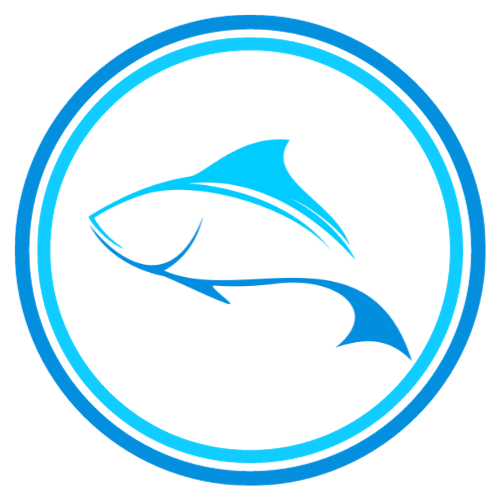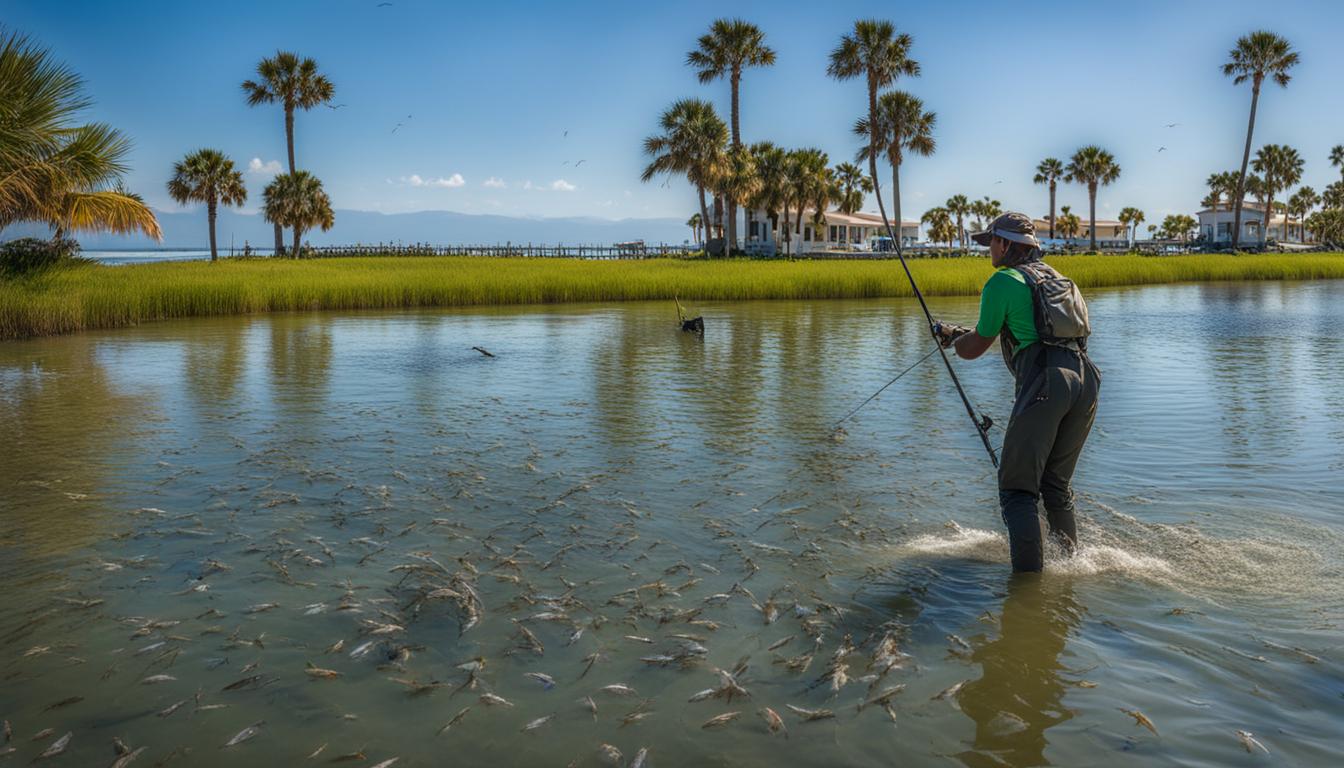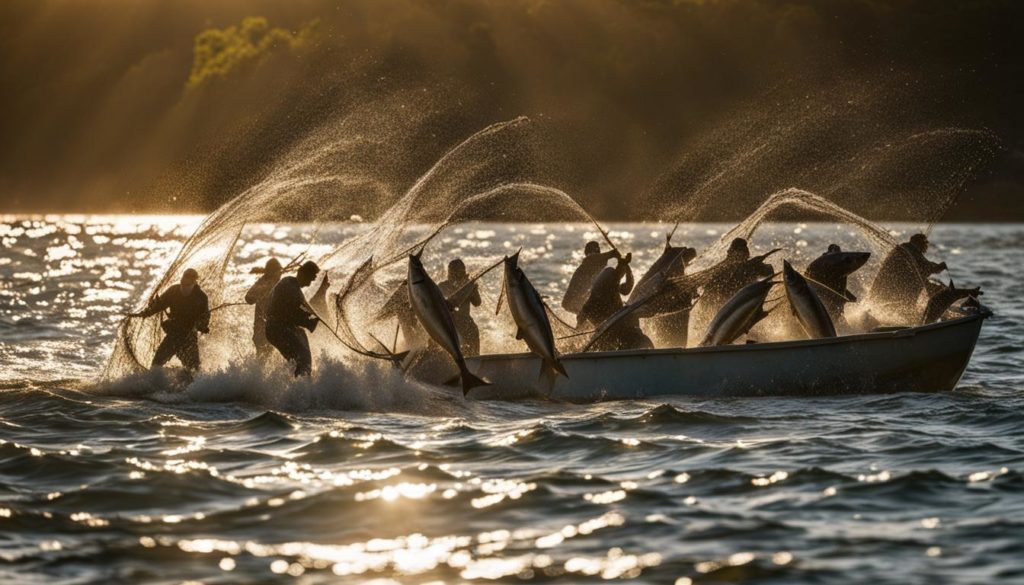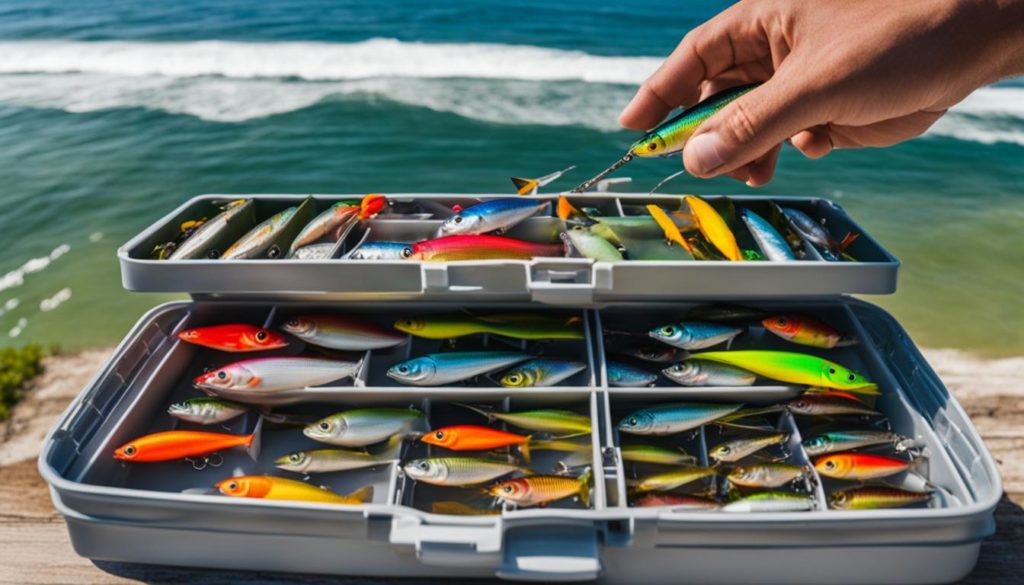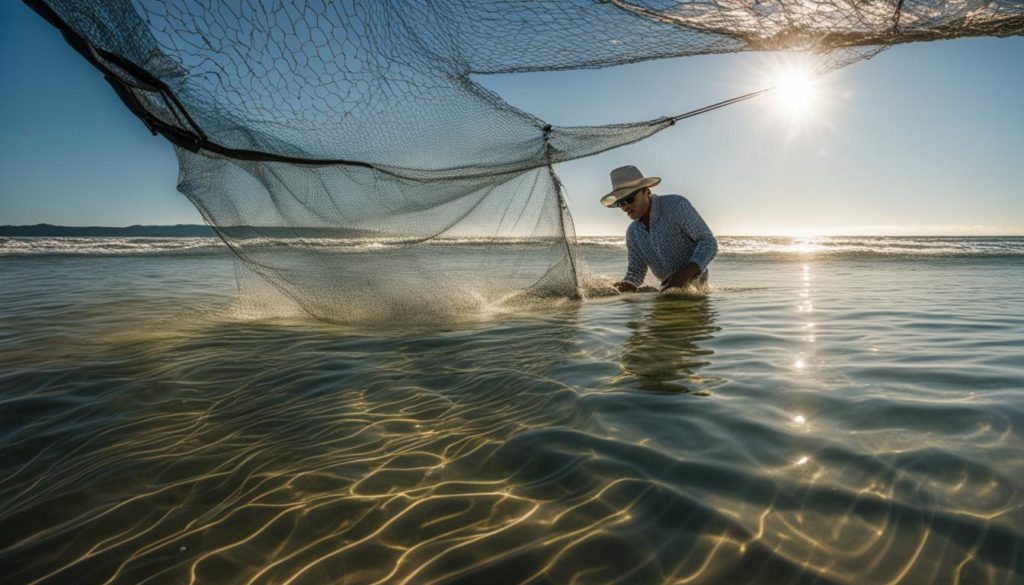Florida is renowned for its exceptional fishing opportunities, attracting anglers from all over the world. Whether you’re a seasoned angler or just starting out, mastering the art of catching bait fish is crucial for a successful fishing trip in Florida. In this comprehensive guide, we will delve into the techniques, tips, and species of bait fish found in Florida, equipping you with the knowledge and skills to become a proficient bait fish angler.
Key Takeaways:
- Learn the importance of using bait fish in Florida fishing
- Familiarize yourself with popular bait fish species in Florida
- Discover the best bait and lures for bait fish catching
- Explore various techniques for catching bait fish in Florida
- Ensure ethical practices when harvesting bait fish
Understanding the Importance of Bait Fish in Florida Fishing
In the world of Florida fishing, bait fish play a critical role. These small fish species serve as primary prey for gamefish like snook, redfish, and tarpon. Understanding the significance of bait fish and their role in the ecosystem is essential for successful fishing trips. By grasping this importance, you can make informed decisions when it comes to selecting bait and lures to attract your target gamefish.
Bait fish act as a crucial link in the food chain of Florida’s waters. They provide a source of sustenance for larger predatory fish, enabling them to thrive in their natural habitats. Gamefish, in particular, rely heavily on bait fish to meet their dietary needs. Bait fish like mullet, pilchards, sardines, pinfish, and shrimp are abundant in Florida waters, making them an irresistible target for gamefish.
When you understand the significance of bait fish as prey for gamefish, you can tailor your fishing approach accordingly. By using bait and lures that mimic the appearance and behavior of these small fish species, you increase your chances of enticing gamefish to strike. By recognizing the vital role that bait fish play in Florida’s fishing ecosystem, you can enhance your fishing experience and increase your chances of reeling in a trophy catch.
The Role of Bait Fish in the Ecosystem
“Bait fish serve as a crucial food source for gamefish in Florida’s waters. Their abundance and availability make them an irresistible target for predatory species.”
Choosing the Right Bait and Lures
When targeting gamefish that feed on bait fish, selecting the right bait and lures becomes paramount. Live bait options such as shrimp, mullet, and pilchards are popular choices for enticing gamefish. These live baits mimic the natural movements and scent of bait fish, making them highly effective. Additionally, artificial lures like crankbaits, spoons, and soft plastics that imitate bait fish can also yield successful results.
Experimenting with different bait and lure options will help you determine what works best for your specific fishing needs. Factors like water conditions, target species, and time of year can influence the bait fish preferences of gamefish. By staying adaptable and open to trying new bait and lure combinations, you increase your chances of success on the water.
In Conclusion
The role of bait fish in Florida fishing cannot be understated. Understanding their importance as prey for gamefish is vital for any angler seeking a successful fishing trip. By choosing the right bait and lures that mimic bait fish, you can increase your chances of enticing gamefish to strike. Remember to adapt your approach based on environmental conditions and the preferences of your target species. With these insights, you’ll be well-equipped to master the art of bait fish catching in the beautiful waters of Florida.
Popular Bait Fish Species in Florida
Florida’s waters are teeming with a diverse array of bait fish species. These common bait fish play a crucial role in the ecosystem and are highly sought after by gamefish. Here are some popular bait fish species you are likely to encounter during your fishing adventures in Florida:
| Bait Fish Species | Description |
|---|---|
| Mullet | Mullet species, such as striped mullet and silver mullet, are known for their large size and strong swimming abilities. They are often used as live bait and are highly effective in attracting gamefish. |
| Pilchards | Pilchards, also known as whitebait or greenbacks, are small, silvery bait fish that are abundant in Florida waters. They are a favorite food source for many gamefish species, making them a popular choice for anglers. |
| Sardines | Sardines are another small and silvery bait fish species found in Florida. They are highly nutritious and attract a wide range of gamefish. Sardines are commonly used as live bait or in cut bait form. |
| Pinfish | Pinfish are small bait fish species characterized by their vibrant colors and sharp spines. They are commonly used as live bait and are particularly effective for attracting predatory gamefish like snook and redfish. |
| Shrimp | While not technically a fish, shrimp are incredibly popular as bait in Florida. They are readily available, easy to use, and attract a wide variety of gamefish. Anglers often use live or frozen shrimp when targeting saltwater species. |
These are just a few examples of the bait fish species you can encounter in Florida’s rich fishing grounds. Each species has its own unique characteristics and can attract specific types of gamefish. It’s important to familiarize yourself with these popular bait fish species to enhance your chances of a successful fishing trip.
Identifying Bait Fish in Florida
When trying to identify bait fish in Florida, there are a few key features to look out for. Bait fish are generally small in size, ranging from a few inches to a foot long, depending on the species. They typically have streamlined bodies and are often silvery or translucent in color.
Additionally, bait fish species in Florida can be identified by their swimming patterns and behavior. Some species, like mullet, are known for their ability to jump out of the water, while others, like sardines and pilchards, tend to swim in tight schools near the surface.
By keeping an eye out for these characteristics and observing the behavior of the fish in the water, you can quickly identify the bait fish species present in Florida’s diverse fishing grounds.
Choosing the Right Bait and Lures
When it comes to successful fishing in Florida, choosing the right bait and lures can make all the difference. Whether you’re targeting snook, redfish, or tarpon, understanding what bait fish they’re feeding on and selecting the best imitations will greatly increase your chances of a catch.
Live bait is a popular choice among anglers, and for good reason. Shrimp, mullet, and pilchards are effective in attracting gamefish. These bait fish species are commonly found in Florida waters and are known to entice even the most wary predators. Using live bait requires proper presentation and technique to mimic the natural movement of bait fish, enticing gamefish to strike.
If you prefer artificial lures, there are a wide variety of options available that imitate bait fish. Soft plastic jerkbaits, swimbaits, and crankbaits are just a few examples. Choose lures that closely resemble the size and color of the bait fish species found in the waters you’re fishing. Experiment with different retrieves and speeds to find what triggers a reaction from gamefish.
Remember, the key to choosing the right bait and lures is to match the hatch. Pay attention to the bait fish species present in the area you’re fishing and select bait and lures that closely resemble them. By doing so, you’ll increase your chances of enticing gamefish and having a successful day on the water.
Table: Common Bait Fish Species in Florida and Best Bait/Lure Choices
| Bait Fish Species | Best Bait Choices | Best Lure Choices |
|---|---|---|
| Mullet | Live shrimp, live mullet, cut mullet | Soft plastic jerkbaits, swimbaits, topwater plugs |
| Pilchards | Live pilchards, frozen pilchards | Soft plastic paddle tails, jerkbaits, spoons |
| Sardines | Live sardines, frozen sardines | Soft plastic swimbaits, jigs, topwater lures |
| Pinfish | Live pinfish, cut pinfish | Soft plastic shrimp imitations, bucktail jigs |
| Shrimp | Live shrimp, frozen shrimp | Soft plastic shrimp imitations, jig heads with shrimp scented baits |
Techniques for Catching Bait Fish in Florida
Mastering the art of catching bait fish in Florida requires employing various effective techniques. Whether you’re a beginner or an experienced angler, understanding these methods will significantly improve your bait fish catching success. Here are some techniques commonly used:
Cast Netting
Cast netting is one of the most popular and effective methods for catching bait fish in Florida. It involves throwing a circular net, known as a cast net, and quickly pulling it back to trap the bait fish. This technique requires practice and skill to accurately cast the net and ensure a successful catch.
Seine Netting
Seine netting is another technique used to catch bait fish in Florida. It involves using a large net with floats on the top and weights on the bottom. The net is dragged through the water, encircling the bait fish and trapping them inside. This method is commonly used in shallow water or near shore areas.
Bait Traps
Using bait traps is a popular method for catching bait fish in Florida. These traps are typically cylindrical or rectangular in shape and baited with food to attract the fish. Once the bait fish enter the trap, they are unable to escape, allowing you to easily retrieve them. Bait traps are a convenient and efficient way to catch bait fish.
It’s important to note that each technique requires specific skills and equipment. Ensure you are familiar with the local regulations and guidelines for bait fish catching in Florida. Experimenting with different techniques will help you find the most effective method for your fishing needs.
Ethical Practices for Catching Bait Fish
When it comes to catching bait fish in Florida, it’s important to adopt ethical practices that promote sustainable and responsible harvesting. By following these guidelines, you can ensure the preservation of bait fish populations and the overall health of the ecosystem.
One key aspect of ethical bait fish catching is respecting size and quantity limits. These limits are put in place to prevent overfishing and allow bait fish populations to replenish. It’s crucial to familiarize yourself with the specific regulations for each bait fish species and adhere to them diligently.
Using appropriate gear is another vital consideration. Avoid using gear that could harm or excessively stress bait fish, such as hooks that are too large or nets with small mesh sizes that can catch juvenile fish. Opt for gear that minimizes harm and facilitates the safe and efficient capture of bait fish.
Lastly, releasing unwanted bait fish back into the water is an essential practice. It allows the fish to continue their natural role in the ecosystem, contributing to the food chain and the overall health of the aquatic environment. This practice also ensures that bait fish populations remain stable and support the gamefish that rely on them as a food source.
Tips for Ethical Bait Fish Catching:
- Respect size and quantity limits set by regulations.
- Use gear that minimizes harm to bait fish.
- Release unwanted bait fish back into the water.
“Sustainable fishing practices not only benefit the environment but also ensure the longevity of the sport for future generations.”
Tips for Finding Bait Fish Hotspots
When it comes to bait fishing in Florida, knowing where to find bait fish hotspots is key to a successful fishing trip. Bait fish tend to congregate in specific areas that offer them protection, food, and suitable habitats. By understanding their preferences and behavior, you can increase your chances of locating bait fish schools and catching more fish. Here are some valuable tips to help you find bait fish hotspots in Florida:
- Look for structure: Bait fish are often found near structures such as mangroves, docks, and rock jetties. These structures provide shelter and attract both bait fish and larger gamefish. Pay close attention to areas with underwater features like rocks, reefs, and ledges, as these can also serve as hotspots for bait fish.
- Observe tidal movements: Tides play a crucial role in bait fish behavior. During incoming or outgoing tides, bait fish are carried along with the current, making them more accessible to predators. Focus your efforts on areas where tidal currents create eddies, bait balls, or other feeding opportunities for bait fish.
- Monitor water conditions: Bait fish prefer clear, clean water with optimal oxygen levels. As such, areas with good water quality are more likely to attract schools of bait fish. Look for signs of bait fish activity such as surface disturbances, diving birds, or fish feeding on the surface. These indicators can lead you to bait fish hotspots.
- Use technology: Take advantage of modern technology to locate bait fish hotspots. Utilize fish finders, depth sounders, and GPS devices to identify underwater structures, depth contours, and areas with high concentrations of bait fish. These tools can greatly enhance your ability to locate bait fish schools and increase your catch rate.
Remember that bait fish hotspots can vary depending on the time of year, weather conditions, and the specific species of bait fish you are targeting. It’s important to stay observant, adapt to changing conditions, and continue to explore different areas to maximize your chances of finding bait fish in Florida.
By following these tips and putting in the necessary effort, you can increase your success in locating bait fish hotspots and improve your overall fishing experience in the beautiful waters of Florida.
| Tip | Description |
|---|---|
| 1. Look for structure | Bait fish are often found near structures such as mangroves, docks, and rock jetties. These structures provide shelter and attract both bait fish and larger gamefish. |
| 2. Observe tidal movements | Tides play a crucial role in bait fish behavior. During incoming or outgoing tides, bait fish are carried along with the current, making them more accessible to predators. |
| 3. Monitor water conditions | Bait fish prefer clear, clean water with optimal oxygen levels. Look for signs of bait fish activity such as surface disturbances, diving birds, or fish feeding on the surface. |
| 4. Use technology | Utilize fish finders, depth sounders, and GPS devices to identify underwater structures, depth contours, and areas with high concentrations of bait fish. |
Best Times to Catch Bait Fish in Florida
Knowing the best times to catch bait fish in Florida can significantly increase your chances of a successful fishing trip. Bait fish are most active during their peak feeding times, which may vary depending on the species and environmental conditions. By understanding these patterns, you can plan your fishing outings accordingly and optimize your bait fish catching strategy.
Generally, early morning and evening hours tend to be productive for catching bait fish in Florida. During these times, bait fish are more active and are actively feeding near the surface. The low light conditions make it easier for them to obtain food and attract gamefish. Consider arriving at your fishing spot before sunrise or staying until sunset to take advantage of these prime fishing hours.
However, it’s important to remember that bait fish species may have specific feeding patterns unique to their behavior. For example, some species may be more active during certain tide cycles or seasons. It’s crucial to familiarize yourself with the feeding habits and patterns of the bait fish species you are targeting to pinpoint the best times for catching them.
Monitoring water conditions is another key factor in determining the best times to catch bait fish in Florida. Factors such as water temperature, clarity, and current can influence the behavior and feeding patterns of bait fish. Warmer water temperatures often lead to increased bait fish activity, while colder temperatures may cause them to be less active. Additionally, bait fish tend to congregate in areas with optimal conditions, such as areas with structure or areas where the current brings in food sources.
Tackle and Gear for Bait Fish Catching
When it comes to bait fish catching in Florida, having the right tackle and gear is crucial to increase your chances of success. Whether you are targeting mullet, pilchards, or shrimp, having the appropriate equipment will make your fishing experience more enjoyable and productive.
Tackle
Choosing the right tackle starts with selecting the appropriate fishing rod and reel. For bait fish catching, a medium to heavy-action spinning rod paired with a quality spinning reel is recommended. This setup provides the necessary strength and sensitivity to handle various bait fish species found in Florida’s waters.
You will also need to have a range of hooks in different sizes to accommodate the various bait fish species. Circle hooks are a popular choice as they are more likely to hook fish in the corner of the mouth, reducing the chances of injury and increasing survival rates when releasing unwanted bait fish.
Gear
Aside from rods, reels, and hooks, there are a few other essential gear items to consider. A cast net is a must-have tool for catching live bait fish such as mullet and pilchards. Make sure to choose a net with the appropriate mesh size for the bait fish species you are targeting.
Additional gear items include a bait bucket or livewell to keep your bait fish alive and well, a bait knife for cutting bait, and a pair of pliers for removing hooks. It’s also important to have a sturdy tackle box or bag to store and organize your tackle and gear.
| Tackle | Gear |
|---|---|
| Spinning rod and reel | Cast net |
| Range of hooks | Bait bucket or livewell |
| Circle hooks | Bait knife |
| Pliers |
Summary
Having the right tackle and gear is essential for bait fish catching in Florida. A medium to heavy-action spinning rod paired with a quality reel is recommended, along with a range of hooks, including circle hooks. Don’t forget to have a cast net for catching live bait fish and a bait bucket or livewell to keep them alive. Additionally, a bait knife and pliers are essential tools to have on hand. By equipping yourself with the proper tackle and gear, you’ll be well-prepared for a successful bait fishing experience in the beautiful waters of Florida.
Tips and Tricks for Bait Fishing in Florida
Mastering the art of bait fishing in Florida requires a combination of technique, strategy, and patience. Here are some valuable tips and tricks to help you improve your bait fishing skills and increase your chances of a successful catch:
1. Proper Bait Presentation
One of the key factors in attracting bait fish is presenting your bait in a natural and enticing manner. Whether you’re using live bait or artificial lures, make sure to mimic the movements of bait fish. Cast your bait near submerged structures, such as rocks or docks, and employ slow and steady retrieval techniques to imitate the natural behavior of bait fish.
2. Using Chum to Attract Bait Fish
Chumming is a highly effective technique for attracting bait fish to your fishing area. By dispersing small pieces of cut bait fish or fish oil in the water, you create a scent trail that can draw in schools of bait fish. This increases your chances of catching larger gamefish that prey on these bait fish. Experiment with different types of chum and find out which works best for the species you’re targeting.
3. Adapting to Different Fishing Conditions
Florida’s fishing conditions can vary greatly depending on factors such as weather, tides, and water clarity. To maximize your success, it’s important to adapt your bait fishing techniques to these conditions. For example, on days with strong currents, you may need to adjust your casting angles and use heavier sinkers to keep your bait in the strike zone. Stay observant and flexible, and be willing to try new approaches when necessary.
By implementing these tips and tricks into your bait fishing routine, you can significantly enhance your chances of a successful catch in the diverse and abundant waters of Florida.
Table: Bait Fish Catching Techniques
| Technique | Description |
|---|---|
| Cast Netting | A popular method for catching bait fish in Florida. It involves throwing a large circular net over a school of bait fish and quickly pulling it back in, trapping the fish within the net. |
| Seine Netting | This technique uses a long, rectangular net with weights on the bottom and floats on the top. The net is dragged through the water to capture bait fish in its path. |
| Bait Traps | These are specially designed traps that bait fish swim into. Bait traps can be baited with food or chum to attract the fish, and once inside, they are unable to escape. |
Conclusion
Mastering the art of catching bait fish in Florida is essential for any angler looking to enhance their fishing success. By understanding the importance of bait fish as prey for gamefish, identifying popular bait fish species, and choosing the right bait and lures, you can significantly increase your chances of a rewarding fishing trip.
Using the proper techniques for catching bait fish, such as cast netting, seine netting, and using bait traps, will provide you with a steady supply of fresh bait for your fishing endeavors. Remember to always practice ethical bait fish catching and ensure sustainable fishing practices to preserve Florida’s bait fish populations for future generations.
When searching for bait fish, focus on areas with structure like mangroves, docks, and rock jetties. These spots often attract bait fish and increase your chances of success. Pay attention to the specific feeding patterns and peak feeding times of different species to determine the best times to catch bait fish in Florida.
Equipping yourself with the right tackle and gear, and applying tips and tricks such as proper bait presentation and using chum to attract bait fish, will further enhance your bait fishing skills. With practice, perseverance, and a good understanding of Florida’s bait fish catching guide, you’ll become a proficient angler ready to explore the beautiful waters of Florida.
FAQ
What are some popular bait fish species found in Florida?
Some popular bait fish species in Florida include mullet, pilchards, sardines, pinfish, and shrimp.
What are the best bait and lures for catching bait fish in Florida?
Popular choices for bait include live shrimp, mullet, and pilchards. Artificial lures that mimic bait fish can also be effective. It’s best to experiment with different options to see what works best for your needs.
What are the different techniques for catching bait fish in Florida?
Some common techniques include cast netting, seine netting, and using bait traps.
How can I find bait fish hotspots in Florida?
Look for areas with structure such as mangroves, docks, and rock jetties, as these attract bait fish. Pay attention to tides, currents, and water conditions as they can influence the location of bait fish schools.
When is the best time to catch bait fish in Florida?
Bait fish are most active during peak feeding times, which can vary depending on the species and environmental conditions. Generally, early morning and evening hours tend to be productive, but it’s important to monitor specific feeding patterns for optimal catching times.
What tackle and gear do I need for bait fish catching in Florida?
You’ll need appropriate rods, reels, lines, and hooks. Different bait fish species may require specific gear, so it’s important to match your equipment to your target bait fish.
What are some tips and tricks for bait fishing in Florida?
Proper bait presentation, using chum to attract bait fish, and adapting your techniques to different fishing conditions are all effective strategies for bait fishing in Florida.
